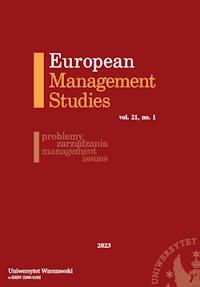Revisiting Balassa-Samuelson Hypothesis for Asia – A Critical Appraisal of Literature
Revisiting Balassa-Samuelson Hypothesis for Asia – A Critical Appraisal of Literature
Author(s): Maryam Ishaq, Felix Puime-Guillén, Raquel Fernández-González, Joanna DudaSubject(s): National Economy, Supranational / Global Economy, Financial Markets, Socio-Economic Research
Published by: Wydawnictwo Naukowe Wydziału Zarządzania Uniwersytetu Warszawskiego
Keywords: open economies macroeconomics; Balassa-Samuelson hypothesis; real exchange rate; purchasing power parity; emerging and developing Asian economies;
Summary/Abstract: Purpose: The present study is aimed at presenting a critical appraisal of the empirical literature on the Balassa-Samuelson hypothesis for emerging and developing Asian countries. Design/methodology/approach: A critical appraisal of the relevant studies is carried out across various important dimensions of the empirical estimation of the Balassa-Samuelson hypothesis including the scheme of sectoral division followed, definitions and proxy variables used for constructing real exchange rate and price series, choice of output and employment series and their subsequent transformation, empirical methodology followed and (theoretically) different variants of the hypothesis chosen for empirical estimation. Findings: Only a handful of studies have investigated the Balassa-Samuelson hypothesis for Asia. Nevertheless, these studies are characterized by a variety of irregularities in dealing with different important features of the theory, which may be of critical importance for yielding consistent empirical estimates. In multi-country studies for Asia, serious inconsistencies are observed whilst handling these critical aspects of the hypothesis. Such irregularities may hold serious implications for model estimates since the empirical evidence from Asia is very mixed, and in many cases, not even robust. Practical implications: The inconsistencies highlighted in this review paper hold strong implications for future research in this area. The selection of price indicators for the construction of real exchange rate series, choice of econometric methodology and the theoretical framework followed are aspects of the empirical verification of the Balassa-Samuelson hypothesis that need to be handled with great caution since they turn out to be most sensitive in relation to yielding intuitively correct and robust model estimates. Originality: To our knowledge, so far, no study on Asia has presented such an extensive appraisal of literature on the productivity-real exchange rate nexus. The present study is therefore novel in the sense that it critically evaluates studies on Asia against all those features of the Balssa-Samuelson theory which may stand responsible for yielding mixed and even contrasting empirical estimates for Asia.
Journal: Problemy Zarządzania
- Issue Year: 21/2023
- Issue No: 1 (99)
- Page Range: 23-47
- Page Count: 25
- Language: English

